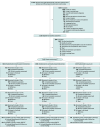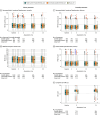Health System, Community-Based, or Usual Dementia Care for Persons With Dementia and Caregivers: The D-CARE Randomized Clinical Trial
- PMID: 39878968
- PMCID: PMC11780506
- DOI: 10.1001/jama.2024.25056
Health System, Community-Based, or Usual Dementia Care for Persons With Dementia and Caregivers: The D-CARE Randomized Clinical Trial
Erratum in
-
Omitted Grant Numbers.JAMA. 2025 May 6;333(17):1549. doi: 10.1001/jama.2025.4753. JAMA. 2025. PMID: 40193097 Free PMC article. No abstract available.
Abstract
Importance: The effectiveness of different approaches to dementia care is unknown.
Objective: To determine the effectiveness of health system-based, community-based dementia care, and usual care for persons with dementia and for caregiver outcomes.
Design, setting, and participants: Randomized clinical trial of community-dwelling persons living with dementia and their caregivers conducted at 4 sites in the US (enrollment June 2019-January 2023; final follow-up, August 2023).
Interventions: Participants were randomized 7:7:1 to health system-based care provided by an advanced practice dementia care specialist (n = 1016); community-based care provided by a social worker, nurse, or licensed therapist care consultant (n = 1016); or usual care (n = 144).
Main outcomes and measures: Primary outcomes were caregiver-reported Neuropsychiatric Inventory Questionnaire (NPI-Q) severity score for persons living with dementia (range, 0-36; higher scores, greater behavioral symptoms severity; minimal clinically important difference [MCID], 2.8-3.2) and Modified Caregiver Strain Index for caregivers (range, 0-26; higher scores, greater strain; MCID, 1.5-2.3). Three secondary outcomes included caregiver self-efficacy (range, 4-20; higher scores, more self-efficacy).
Results: Among 2176 dyads (individuals with dementia, mean age, 80.6 years; 58.4%, female; and 20.6%, Black or Hispanic; caregivers, mean age, 65.2 years; 75.8%, female; and 20.8% Black or Hispanic), primary outcomes were assessed for more than 99% of participants, and 1343 participants (62% of those enrolled and 91% still alive and had not withdrawn) completed the study through 18 months. No significant differences existed between the 2 treatments or between treatments vs usual care for the primary outcomes. Overall, the least squares means (LSMs) for NPI-Q scores were 9.8 for health system, 9.5 for community-based, and 10.1 for usual care. The difference between health system vs community-based care was 0.30 (97.5% CI, -0.18 to 0.78); health system vs usual care, -0.33 (97.5% CI, -1.32 to 0.67); and community-based vs usual care, -0.62 (97.5% CI, -1.61 to 0.37). The LSMs for the Modified Caregiver Strain Index were 10.7 for health system, 10.5 for community-based, and 10.6 for usual care. The difference between health system vs community-based care was 0.25 (97.5% CI, -0.16 to 0.66); health system vs usual care, 0.14 (97.5% CI, -0.70 to 0.99); and community-based vs usual care, -0.10 (97.5% CI, -0.94 to 0.74). Only the secondary outcome of caregiver self-efficacy was significantly higher for both treatments vs usual care but not between treatments: LSMs were 15.1 for health system, 15.2 for community-based, and 14.4 for usual care. The difference between health system vs community-based care was -0.16 (95% CI, -0.37 to 0.06); health system vs usual care, 0.70 (95% CI, 0.26-1.14); and community-based vs usual care, 0.85 (95% CI, 0.42 to 1.29).
Conclusions and relevance: In this randomized trial of dementia care programs, no significant differences existed between health system-based and community-based care interventions nor between either active intervention or usual care regarding patient behavioral symptoms and caregiver strain.
Trial registration: ClinicalTrials.gov Identifier: NCT03786471.
Conflict of interest statement
Figures


Comment in
-
Challenges and Innovations in Dementia Care-Evaluating Comprehensive Models.JAMA. 2025 Mar 18;333(11):943-945. doi: 10.1001/jama.2024.28066. JAMA. 2025. PMID: 39878988 No abstract available.
References
-
- 2024. Alzheimer’s disease facts and figures. Accessed April 20, 2024. https://www.alz.org/alzheimers-dementia/facts-figures - PMC - PubMed
-
- Lees Haggerty K, Epstein-Lubow G, Spragens LH, et al. Recommendations to improve payment policies for comprehensive dementia care. J Am Geriatr Soc. 2020;68(11):2478-2485. - PubMed

